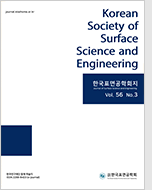
- Past Issues
- e-Submission
-

2021 Impact Factor 1.766
5-Year Impact Factor 1.674
Editorial Office
- +82-2-563-0935
- +82-2-558-2230
- submission@kssse.or.kr
- https://www.kssse.or.kr/

2021 Impact Factor 1.766
5-Year Impact Factor 1.674
The Korean Society of Surface Science and Engineering 2024;57(5):368-378. Published online: Nov, 5, 2024
DOI : https://doi.org/10.5695/JSSE.2024.57.5.368
The growing environmental concerns due to increased fossil fuel consumption have intensified the demand for sustainable and economically viable energy sources. Among the various energy storage devices, lithium-ion batteries (LIBs) are widely used in electronic devices and electric vehicles due to their high energy density and excellent cycle life. However, LIBs face challenges such as safety concerns due to side reactions, thermal expansion, and explosion risks, along with issues of limited resource availability and high costs. As a result, multivalent metals such as calcium, magnesium, zinc, iron, and aluminum are being explored as alternatives to lithium. Recently, there has been significant interest in developing aqueous zinc-ion battery (AZIB) due to their use of water as an electrolyte solvent, which enhances safety by reducing the risk of fire even in the event of a short circuit. Additionally, AZIBs offer benefits such as non-toxicity, fast ion conductivity, high volumetric capacity, and cost-effectiveness due to the abundance of zinc. Despite these advantages, AZIBs face challenges including dendrite formation on the zinc anode during cycling, leading to short circuits, corrosion, and hydrogen gas evolution, which can compromise battery performance and safety. This review discusses the underlying mechanisms of these issues and explores various strategies to stabilize the zinc anode and improve the overall performance of AZIBs.
Keywords Aqueous zinc-ion battery; Anode; Dendrite; Hydrogen gas evolution.